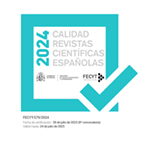Envíos
Lista de comprobación para la preparación de envíos
Como parte del proceso de envío, los autores/as están obligados a comprobar que su envío cumpla todos los elementos que se muestran a continuación. Se devolverán a los autores/as aquellos envíos que no cumplan estas directrices.- El envío de un documento a esta revista supone la aceptación de la Declaración de originalidad y autoría. Descargar documento
- El fichero enviado está en formato OpenOffice, Microsoft Word, RTF, PDF o WordPerfect.
- Se han añadido las direcciones web para las referencias donde ha sido posible.
- Se han añadido las referencias DOI en los casos en los que existen.
- El texto cumple con los requisitos bibliográficos y de estilo indicados en las Directrices para autoras/es, que se pueden encontrar en Acerca de.
- Si está enviando una propuesta a una sección de la revista que se revisa por pares, tiene que asegurase de que las instrucciones de Revisión ciega han sido seguidas.
Aviso de derechos de autor/a
La revista Círculo de Lingüística Aplicada a la Comunicación, para fomentar el intercambio global del conocimiento, facilita el acceso sin restricciones a sus contenidos desde el momento de su publicación en la presente edición electrónica, y por eso es una revista de acceso abierto. Los originales publicados en esta revista son propiedad de la Universidad Complutense de Madrid y es obligatorio citar su procedencia en cualquier reproducción total o parcial. Todos los contenidos se distribuyen bajo una licencia de uso y distribución Creative Commons Reconocimiento 4.0 (CC BY 4.0). Esta circunstancia ha de hacerse constar expresamente de esta forma cuando sea necesario. Puede consultar la versión informativa y el texto legal de la licencia.
Declaración de privacidad
Información básica sobre la actividad de tratamiento: Servicio de Publicaciones
| Responsable | Vicerrectorado de Cultura, Deporte y Extensión Universitaria +info |
| Finalidad | Divulgación, venta, facturación y envío de publicaciones +info |
| Legitimación | Misión en interés público; ejecución de contrato +info |
| Destinatarios | No se cederán datos a terceros, salvo obligación legal +info |
| Derechos | Acceder, rectificar y suprimir los datos, así como otros derechos, explicados en la información adicional +info |
| Información adicional |
Puede consultarla con detalle en nuestra página web: |










